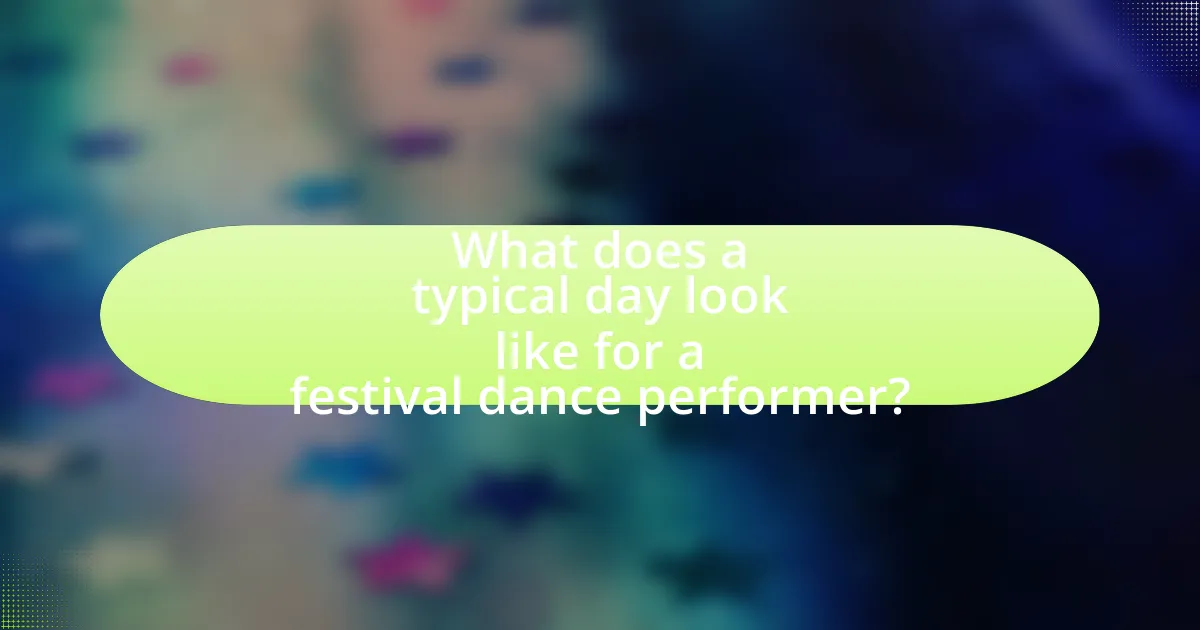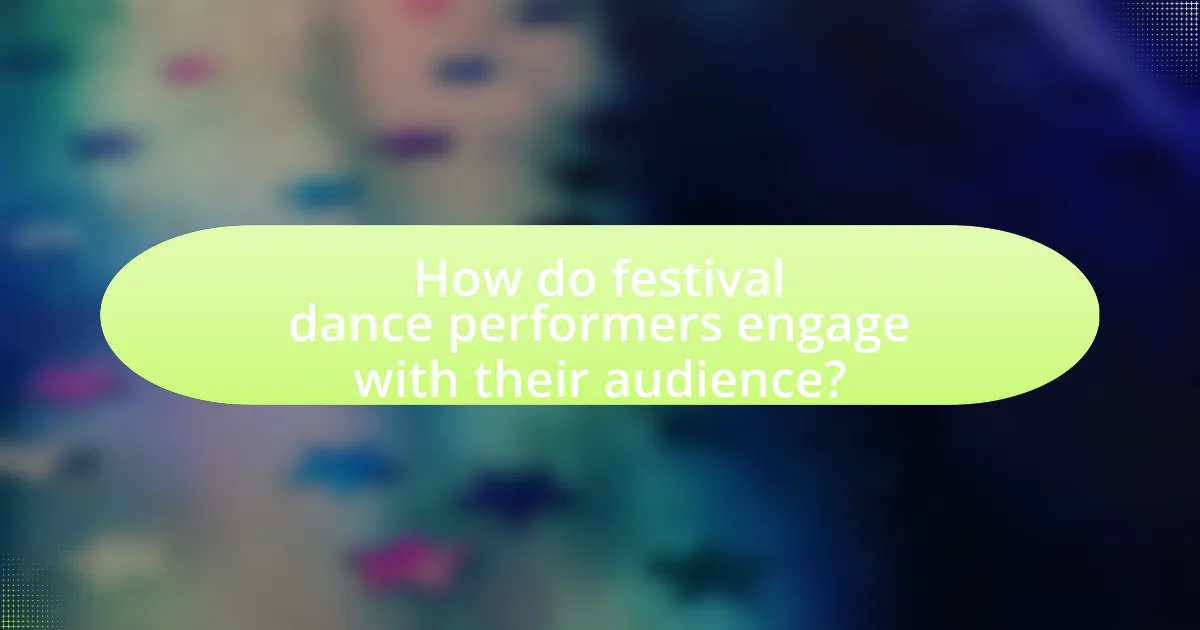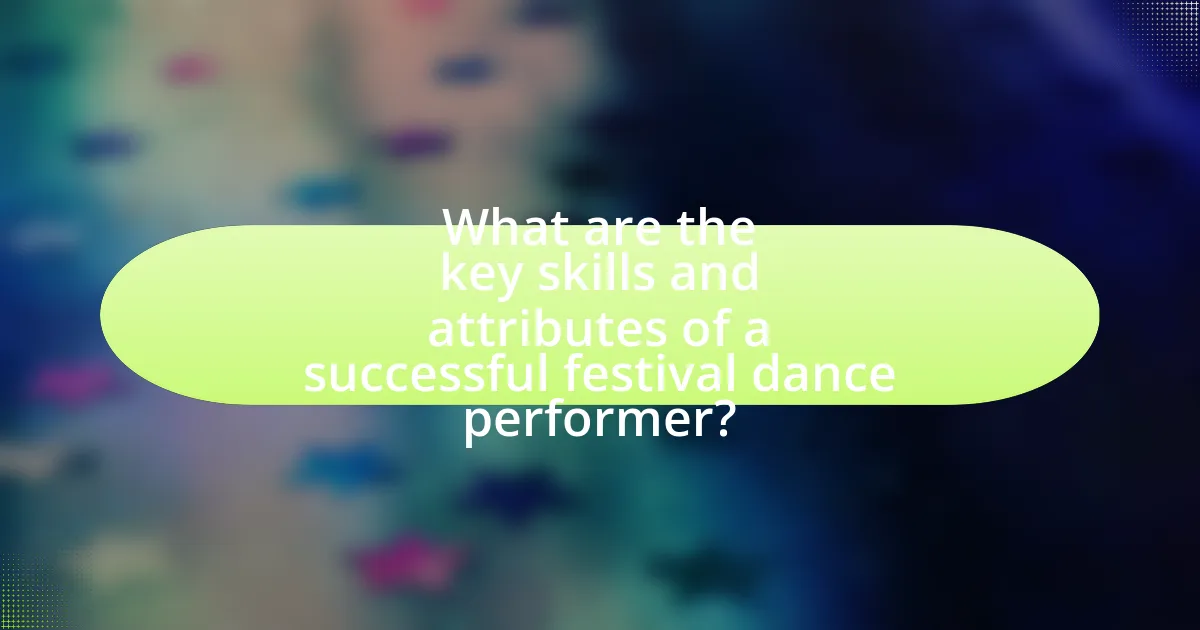A festival dance performer’s day is characterized by a structured routine that includes physical warm-ups, rehearsals, costume preparation, and performances. The preparation process is essential for maintaining peak physical condition and involves mental techniques to cope with performance anxiety. Throughout the day, performers engage in networking activities and face challenges such as physical fatigue and logistical issues. Audience engagement is crucial, enhancing the performance quality and fostering connections that can lead to future opportunities. Key skills for success include technical proficiency, creativity, resilience, and teamwork, all of which contribute to a performer’s ability to captivate and connect with their audience.

What does a typical day look like for a festival dance performer?
A typical day for a festival dance performer involves rigorous preparation, performance, and post-performance activities. The day usually begins early with a warm-up session to prepare the body for the physical demands of dancing, often lasting one to two hours. Following the warm-up, performers typically engage in rehearsals to refine their routines and synchronize with fellow dancers, which can take several hours.
As the festival approaches, performers may participate in costume fittings and makeup application, ensuring they are visually ready for the stage. The performance itself usually occurs in the afternoon or evening, where dancers showcase their skills to an audience, often lasting from 30 minutes to an hour. After the performance, performers may engage in meet-and-greet sessions with fans or participate in promotional activities for the festival.
This structured routine is essential for maintaining peak physical condition and delivering high-quality performances, reflecting the demanding nature of the profession.
How do festival dance performers prepare for their day?
Festival dance performers prepare for their day by engaging in a structured routine that includes physical warm-ups, costume checks, and mental rehearsals. Physical warm-ups typically involve stretching and practicing dance movements to prevent injuries and enhance performance quality. Costume checks ensure that all attire and accessories are in place and functional, as any wardrobe malfunction can disrupt a performance. Mental rehearsals involve visualizing the dance routines and focusing on the performance goals, which helps to build confidence and reduce anxiety. This preparation process is crucial for delivering a successful performance at festivals, where the energy and precision of the dancers are key to audience engagement.
What routines do they follow in the morning?
Festival dance performers typically follow a structured morning routine that includes physical warm-ups, nutrition, and mental preparation. They begin their day with stretching and exercises to enhance flexibility and strength, which are crucial for their performances. Following the physical warm-up, they consume a balanced breakfast rich in carbohydrates and proteins to fuel their energy levels for the day ahead. Additionally, performers often engage in mental practices such as visualization techniques or meditation to focus their minds and enhance their performance skills. This combination of physical, nutritional, and mental routines prepares them effectively for the demands of their performances.
How do they mentally prepare for performances?
Performers mentally prepare for performances through techniques such as visualization, mindfulness, and routine establishment. Visualization involves imagining the performance in detail, which helps reduce anxiety and enhance confidence. Mindfulness practices, such as deep breathing and meditation, allow performers to stay present and focused, minimizing distractions. Establishing a pre-performance routine, including warm-ups and mental affirmations, creates a sense of familiarity and control, further aiding in their mental readiness. These methods are supported by research indicating that mental preparation can significantly improve performance outcomes and reduce stress levels among performers.
What activities fill a festival dance performer’s day?
A festival dance performer’s day is filled with rehearsals, costume preparation, performances, and networking. Rehearsals typically occur in the morning to refine choreography and synchronize with fellow dancers. Costume preparation involves selecting, fitting, and sometimes altering outfits to ensure they are stage-ready. Performances take place throughout the day, often in front of large audiences, showcasing the dancer’s skills and cultural expressions. Networking with other performers and festival organizers is also crucial, as it helps build relationships for future opportunities. These activities are essential for maintaining the performer’s craft and enhancing their visibility in the dance community.
How do they balance rehearsals and performances?
Festival dance performers balance rehearsals and performances by meticulously scheduling their time and prioritizing both activities. They often allocate specific days for intensive rehearsals while reserving performance days for showcasing their skills. This structured approach allows them to maintain peak physical condition and artistic expression. For instance, a study by the University of California found that performers who followed a balanced rehearsal-performance schedule reported lower stress levels and improved performance quality. This evidence supports the effectiveness of a well-planned routine in managing both rehearsals and performances efficiently.
What role does networking play in their daily routine?
Networking plays a crucial role in the daily routine of a festival dance performer by facilitating connections with other artists, promoters, and industry professionals. These connections are essential for securing performance opportunities, collaborating on projects, and gaining visibility in the competitive dance scene. For instance, performers often attend workshops, social events, and rehearsals where they can meet influential figures in the industry, which can lead to invitations for performances or participation in larger productions. Additionally, maintaining relationships through social media platforms allows performers to share their work and stay informed about upcoming events, further enhancing their career prospects.
What challenges do festival dance performers face throughout the day?
Festival dance performers face several challenges throughout the day, including physical fatigue, weather conditions, and logistical issues. Physical fatigue arises from the demanding nature of dance routines, which can lead to exhaustion and injuries, as performers often engage in multiple performances in a single day. Weather conditions, such as extreme heat or rain, can impact both the performers’ comfort and their ability to execute routines effectively. Logistical issues, including costume changes, transportation to different stages, and coordination with other performers, can create additional stress and hinder performance quality. These challenges are well-documented in studies of performing arts, highlighting the rigorous demands placed on dancers during festivals.
How do they manage physical fatigue during long events?
Performers manage physical fatigue during long events by implementing a combination of hydration, nutrition, rest, and strategic pacing. Hydration is crucial, as it helps maintain energy levels and prevents dehydration, which can exacerbate fatigue. Consuming balanced meals rich in carbohydrates and proteins before and during the event provides the necessary fuel for sustained energy. Additionally, performers often incorporate short breaks to rest and recover, allowing their bodies to recuperate. Pacing themselves throughout the performance helps to conserve energy and avoid burnout. Research indicates that proper hydration and nutrition can significantly enhance endurance and performance quality, as highlighted in studies on athletic performance and recovery.
What strategies do they use to cope with performance anxiety?
Performers cope with performance anxiety through various strategies, including deep breathing exercises, visualization techniques, and positive self-talk. Deep breathing helps to calm the nervous system, allowing performers to focus better. Visualization involves imagining a successful performance, which can enhance confidence and reduce anxiety. Positive self-talk reinforces a performer’s belief in their abilities, countering negative thoughts that may arise before or during a performance. Research indicates that these techniques can significantly lower anxiety levels and improve performance outcomes, as evidenced by studies in sports psychology that highlight their effectiveness in high-pressure situations.

How do festival dance performers engage with their audience?
Festival dance performers engage with their audience through interactive movements, eye contact, and inviting participation. These performers often incorporate gestures that encourage audience members to join in, creating a shared experience. For instance, many traditional dances include call-and-response elements, where the audience is prompted to respond vocally or physically, enhancing their involvement. Additionally, performers may move closer to the audience, breaking the fourth wall and fostering a sense of connection. This engagement strategy is supported by studies showing that audience participation can significantly enhance the overall enjoyment and emotional impact of live performances.
What techniques do they use to connect with festival-goers?
Festival dance performers use techniques such as interactive choreography, audience engagement, and social media integration to connect with festival-goers. Interactive choreography involves inviting audience participation, allowing attendees to join in dance routines, which fosters a sense of community and shared experience. Audience engagement is enhanced through direct eye contact, smiles, and gestures, creating a personal connection that resonates with festival-goers. Additionally, performers leverage social media platforms to share behind-the-scenes content and engage with fans before, during, and after the event, further solidifying their connection with the audience. These methods are effective in creating memorable experiences that encourage repeat attendance and foster loyalty among festival-goers.
How does audience interaction enhance their performance?
Audience interaction enhances a performer’s performance by creating a dynamic and engaging atmosphere that boosts energy levels and emotional connection. When performers receive immediate feedback through applause, cheers, or even silence, they can adjust their energy and style in real-time, leading to a more captivating experience. Studies have shown that performers who engage with their audience report higher levels of satisfaction and motivation, which can translate into improved performance quality. For instance, a study published in the Journal of Experimental Psychology found that performers who interacted with their audience experienced increased adrenaline levels, enhancing their physical and emotional expression on stage.
What feedback do they seek from the audience?
Festival dance performers seek feedback from the audience regarding their emotional engagement and overall enjoyment of the performance. This feedback helps performers understand how effectively they conveyed their artistic expression and whether the audience connected with the themes presented. Audience reactions, such as applause, cheers, or comments, serve as indicators of the performance’s impact, allowing dancers to refine their craft and enhance future performances.
Why is audience engagement important for festival dance performers?
Audience engagement is crucial for festival dance performers because it enhances the overall performance experience and fosters a connection between the dancers and the audience. Engaged audiences are more likely to respond positively, which can elevate the energy of the performance and create a memorable atmosphere. Studies show that performances with high audience interaction lead to increased satisfaction and emotional impact, as seen in events like the Edinburgh Festival Fringe, where audience participation significantly boosts performers’ ratings and feedback. This connection not only benefits the performers through immediate reactions but also contributes to their reputation and future opportunities in the dance community.
How does it impact their performance quality?
The impact on performance quality for festival dance performers is significant, as it directly influences their ability to engage the audience and deliver an impactful experience. Factors such as physical conditioning, mental focus, and emotional expression contribute to the overall quality of their performances. For instance, a study published in the Journal of Dance Medicine & Science indicates that dancers who maintain rigorous training and conditioning exhibit improved stamina and technique, leading to higher performance quality. Additionally, performers who cultivate a strong mental state and emotional connection to their art are more likely to resonate with audiences, enhancing the overall impact of their performances.
What long-term benefits does audience engagement provide?
Audience engagement provides long-term benefits such as increased loyalty, enhanced brand reputation, and improved audience retention. Engaged audiences are more likely to return for future events, as evidenced by studies showing that 70% of attendees at festivals return when they feel a connection to the performers and the experience. Additionally, strong audience engagement fosters positive word-of-mouth, which can lead to higher attendance rates and greater visibility for future performances. This creates a sustainable cycle of growth and community building around the festival and its performers.

What are the key skills and attributes of a successful festival dance performer?
A successful festival dance performer possesses strong technical skills, creativity, and the ability to engage an audience. Technical skills include proficiency in various dance styles, rhythm, and coordination, which are essential for executing complex choreography. Creativity allows performers to interpret music and express emotions through movement, enhancing the overall performance. Engaging an audience is crucial, as it involves charisma, stage presence, and the ability to connect with spectators, making the performance memorable. These attributes are supported by the fact that performers often undergo rigorous training and practice to refine their skills, ensuring they can deliver high-quality performances at festivals.
What dance techniques are essential for festival performers?
Essential dance techniques for festival performers include contemporary, hip-hop, and traditional folk dance styles. Contemporary dance allows performers to express emotions and connect with audiences through fluid movements, while hip-hop emphasizes rhythm and energy, making it engaging for festival crowds. Traditional folk dance techniques are crucial as they reflect cultural heritage and engage audiences through storytelling and community participation. These techniques are validated by their widespread use in various festivals globally, showcasing their effectiveness in captivating and entertaining diverse audiences.
How do they develop their choreography skills?
They develop their choreography skills through consistent practice, formal training, and collaboration with other dancers. Regular practice allows performers to refine their movements and techniques, while formal training often includes attending dance schools or workshops that provide structured learning. Collaboration with other dancers fosters creativity and exposes them to diverse styles and ideas, enhancing their choreographic abilities. Research indicates that dancers who engage in collaborative projects often experience significant improvements in their choreography skills due to the exchange of techniques and concepts.
What role does improvisation play in their performances?
Improvisation plays a crucial role in the performances of festival dance performers by allowing them to express creativity and adapt to the dynamic environment of live events. This spontaneity enhances the connection with the audience, as performers can respond to the energy and reactions of the crowd, creating a unique experience each time. Studies in performance arts highlight that improvisation fosters individual expression and collaboration among dancers, contributing to the overall fluidity and excitement of the performance.
What personal attributes contribute to their success?
Resilience and adaptability are key personal attributes that contribute to the success of festival dance performers. Resilience allows them to overcome challenges such as physical fatigue and performance pressure, while adaptability enables them to adjust to varying environments and audience expectations. Studies show that performers who exhibit these traits are more likely to thrive in dynamic settings, as they can maintain high energy levels and engage effectively with diverse crowds. For instance, a survey conducted by the National Endowment for the Arts found that adaptability in artists correlates with increased audience satisfaction and performance longevity.
How does teamwork influence their performance outcomes?
Teamwork significantly enhances performance outcomes for festival dance performers by fostering collaboration, improving coordination, and increasing motivation. When dancers work together, they can synchronize their movements more effectively, leading to a more polished and cohesive performance. Research indicates that teams that communicate well and support each other tend to achieve higher levels of creativity and innovation, which are crucial in dance performances. For instance, a study published in the Journal of Applied Psychology found that teams with strong interpersonal relationships outperformed those with weaker connections by 20% in creative tasks. This collaborative environment not only boosts individual confidence but also elevates the overall quality of the performance, resulting in a more engaging experience for the audience.
What importance does resilience have in their career?
Resilience is crucial for a festival dance performer’s career as it enables them to overcome challenges and setbacks inherent in the industry. The demanding nature of performances, including physical strain and emotional pressure, requires dancers to bounce back from failures, injuries, or criticism. Studies indicate that resilient individuals are more likely to maintain motivation and achieve long-term success, as they can adapt to changing circumstances and persist despite difficulties. For example, a survey by the National Endowment for the Arts found that artists who exhibit resilience are more likely to sustain their careers over time, highlighting the importance of this trait in navigating the competitive landscape of performance arts.
What tips can aspiring festival dance performers follow to succeed?
Aspiring festival dance performers can succeed by focusing on consistent practice, understanding their audience, and networking within the dance community. Consistent practice enhances technical skills and performance quality, which is crucial for captivating audiences. Understanding the audience allows performers to tailor their routines to fit the festival’s theme and energy, increasing engagement. Networking with other dancers and industry professionals can lead to collaboration opportunities and exposure, essential for career growth in the competitive festival scene.
How can they effectively network within the festival community?
To effectively network within the festival community, performers should actively engage with other artists, organizers, and attendees during events. Building relationships can be achieved by participating in workshops, collaborating on projects, and attending social gatherings associated with the festival. Research indicates that networking can lead to increased opportunities; for instance, a study by the National Endowment for the Arts found that artists who engage in community activities are more likely to receive performance invitations and collaborations.
What practices can enhance their performance skills?
Regular practice, including daily rehearsals and technique drills, can significantly enhance performance skills for festival dance performers. Engaging in consistent training helps to build muscle memory, improve coordination, and refine movements. Additionally, participating in workshops and masterclasses led by experienced instructors exposes performers to new styles and techniques, fostering growth. Research indicates that dancers who incorporate cross-training, such as strength training and flexibility exercises, experience improved overall performance and reduced injury risk. For instance, a study published in the Journal of Dance Medicine & Science found that dancers who engaged in strength training showed a 20% increase in performance efficiency.
